- Home
- About
- Map
- Trips
- Bringing Boat West
- Migration West
- Solo Motorcycle Ride
- Final Family XC Trip
- Colorado Rockies
- Graduates' XC Trip
- Yosemite & Nevada
- Colorado & Utah
- Best of Utah
- Southern Loop
- Pacific Northwest
- Northern Loop
- Los Angeles to NYC
- East Coast Trips
- 1 Week in Quebec
- Southeast Coast
- NH Backpacking
- Martha's Vineyard
- Canadian Maritimes
- Ocracoke Island
- Edisto Island
- First Landing '02
- Hunting Island '02
- Stowe in Winter
- Hunting Island '01
- Lake Placid
- Chesapeake
- Provincetown
- Hunting Island '00
- Acadia in Winter
- Boston Suburbs
- Niagara Falls
- First Landing '99
- Cape Hatteras
- West Coast Trips
- Utah Off-Roading
- Maui
- Mojave 4WD Course
- Colorado River Rafting
- Bishop & Death Valley
- Kauai
- Yosemite Fall
- Utah Off-Road
- Lost Coast
- Yosemite Valley
- Arizona and New Mexico
- Pescadero & Capitola
- Bishop & Death Valley
- San Diego, Anza Borrego, Joshua Tree
- Carmel
- Death Valley in Fall
- Yosemite in the Fall
- Pacific Northwest
- Utah Off-Roading
- Southern CA Deserts
- Yosemite & Covid
- Lake Powell Covid
- Eastern Sierra & Covid
- Bishop & Death Valley
- Central & SE Oregon
- Mojave Road
- Eastern Sierra
- Trinity Alps
- Tuolumne Meadows
- Lake Powell Boating
- Eastern Sierra
- Yosemite Winter
- Hawaii
- 4WD Eastern Sierra
- 4WD Death Valley +
- Southern CA Deserts
- Christmas in Tahoe
- Yosemite & Pinnacles
- Totality
- Yosemite & Sierra
- Yosemite Christmas
- Yosemite, San Diego
- Yosemite & North CA
- Seattle to Sierra
- Southwest Deserts
- Yosemite & Sierra
- Pacific Northwest
- Yosemite & South CA
- Pacific Northwest
- Northern California
- Southern Alaska
- Vancouver Island
- International Trips
- Index
- Tips
- Books
- Photos/Videos
- Search
- Contact
Española Island, Ecuador
Saturday, March 25, 2023 - 3:00pm by Lolo
0 miles and 0 hours from our last stop - 1 night stay
Travelogue
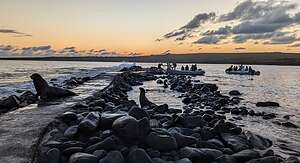 Landing on Punta Suarez,After cruising through the night, we woke up anchored off the island of Española, the southernmost and oldest island in the Galapagos.
Landing on Punta Suarez,After cruising through the night, we woke up anchored off the island of Española, the southernmost and oldest island in the Galapagos.
This island is famous for being the breeding site for waved albatross, an amazing bird with a 2.5 meter wingspan, known for their less than graceful landing, where many of them just fall over when they hit the ground.
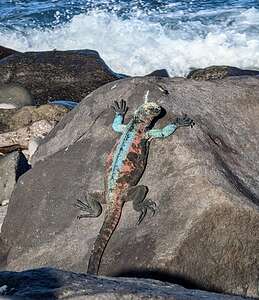 Christmas iguanaUnfortunately, we were a month too early for their arrival. No reason for complaint though, because March is one of the best months to visit the Galapagos as so many other animals are mating then.
Christmas iguanaUnfortunately, we were a month too early for their arrival. No reason for complaint though, because March is one of the best months to visit the Galapagos as so many other animals are mating then.
We started our day with a 6:00 a.m. dry landing on Punta Suarez, on the western tip of Española, where we were greeted by sea lions, also starting their day.
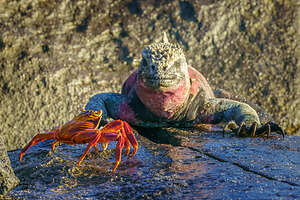 Christmas Iguana and his little buddyFrom there, we took a trail inland across to the other side of the point.
Christmas Iguana and his little buddyFrom there, we took a trail inland across to the other side of the point.
It wasn’t too long before we met the Española marine iguana, who during breeding season (which luckily for us was now) turns a bright red and green, earning it the nickname Christmas Iguana.
All the many marine iguanas we had met to date on the other islands were black, but on this remote island, the marine iguanas have evolved in their own distinct way. It is thought that their coloring might be the result of eating algae endemic to Española.
 Lava LizardThey look like contestants in an Ugly Christmas Sweater contest, except theirs is quite unique and beautiful.
Lava LizardThey look like contestants in an Ugly Christmas Sweater contest, except theirs is quite unique and beautiful.
They obviously liked climbing rocks and sunning themselves.
Continuing inland along the trail, we came to a series of tall rock formations where a colony of Nazca boobies was nesting. The Nazca Boobies are the largest of the Galapagos boobies, so they nest on high rocks to give themselves a bit of takeoff assistance from the wind.
 Nazca Booby feeding her hatchlingNazca boobies just recently graduated to being their own species. They were previously thought to be a subspecies of the naked booby, but they were differentiated from the masked booby due to its larger size, breeding range, and bill color.
Nazca Booby feeding her hatchlingNazca boobies just recently graduated to being their own species. They were previously thought to be a subspecies of the naked booby, but they were differentiated from the masked booby due to its larger size, breeding range, and bill color.
They are beautiful white birds with black feathers on their tales. The males have yellow or orange beaks, while the females beaks are a paler pink. Somewhat unusual for the animal kingdom, the female is larger than the male. Unlike the more flamboyant blue-footed and red-footed boobies, Nazca feet are gray.
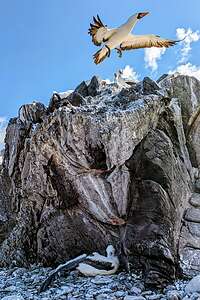 Nazca Booby nesting areaThe white, fuzzy little hatchlings were adorable, but I later found out that these little fuzzballs had a dark side and practiced what is known as obligate siblicide.
Nazca Booby nesting areaThe white, fuzzy little hatchlings were adorable, but I later found out that these little fuzzballs had a dark side and practiced what is known as obligate siblicide.
Unlike the other boobies, Nazca boobies often lay two eggs, a couple of days apart. One of the hatchlings then proceeds to kick the other one out of the nest to avoid competing for food. It gets worse. The mom does nothing about the situation - no scolding or “time out” for the bully sibling. She doesn’t even acknowledge the unwanted chick and it quickly dies from either starvation, temperature change, or predation. Her excuse: she only has the energy and resources to raise one chick.
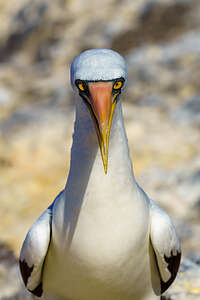 Serious Nazca boobyThis process might seem cruel, but I guess it is an evolutionary adaptation that helps the survival of the Nazca booby species by only allowing the fitter ones to grow up and procreate.
Serious Nazca boobyThis process might seem cruel, but I guess it is an evolutionary adaptation that helps the survival of the Nazca booby species by only allowing the fitter ones to grow up and procreate.
Another interesting fact about the Nazca boobies, which I’m kind of glad we didn’t see, is that they are prey to the vampire finches, who peck away at the Nazcas and feed on their blood. The boobies hardly even take notice.
Wow! It’s not all sunshine and roses in the Galapagos, but that’s what evolution is all about - adaptive behaviors and traits to survive.
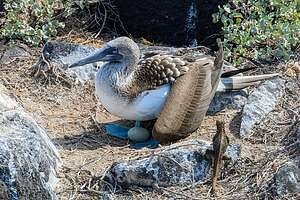 Blue-footed booby nesting in the trailLater along the trail (and I mean literally along the trail), we saw blue-footed boobies incubating their eggs. They could care less about our presence.
Blue-footed booby nesting in the trailLater along the trail (and I mean literally along the trail), we saw blue-footed boobies incubating their eggs. They could care less about our presence.
So, just when I thought we had seen it all, we got to meet two new creatures: the Christmas marine iguana and the Nazca Booby.
 Snorkeling with sea lionsThen it was back to the boat to get into our wetsuits and get back in the pangas for our late morning snorkel, which I think was near Turtle Rock. We saw lots of sea lions zipping about, Mexican hogfish, Giant hawkfish, King angelfish, and more.
Snorkeling with sea lionsThen it was back to the boat to get into our wetsuits and get back in the pangas for our late morning snorkel, which I think was near Turtle Rock. We saw lots of sea lions zipping about, Mexican hogfish, Giant hawkfish, King angelfish, and more.
Back on the Tip Top IV, we had lunch and were given some free time. Herb and I immediately headed to the upper deck to claim two lounge chairs, where we spent a delightful, relaxing hour reading and snoozing before the ship bell rang calling us back into action.
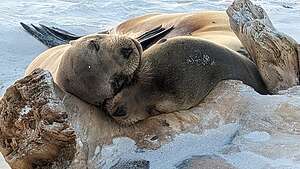 Cuddling sea lionsWe all piled onto the pangas and cruised over to a beautiful crescent Beach on Gardner Bay with a sea lion colony.
Cuddling sea lionsWe all piled onto the pangas and cruised over to a beautiful crescent Beach on Gardner Bay with a sea lion colony.
Once on the beach we were able to wander among the Sea Lion colony, while they rolled in the sand, played in the surf, lined up to take a nap in what looked like a long line of sausages, and other cute things.
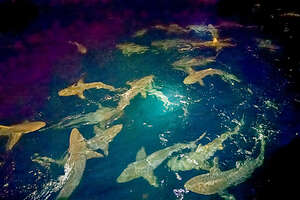 Black-tipped sharks feeding frenzyWe did have to remember to give the males a wide berth though because they can be a little defensive if you get too near them or their territory.
Black-tipped sharks feeding frenzyWe did have to remember to give the males a wide berth though because they can be a little defensive if you get too near them or their territory.
Another good day, but there was one more bit of excitement still to come. After our evening briefing and dinner, we are all usually so exhausted that we retire to our cabins and pass out.
Just as we finished our dinners, a crew member called us to come quickly outside onto the deck. He said something about sharks.
 Flying fishHe wasn’t kidding. Dozens of black-tipped sharks were churning up the water in a feeding frenzy. One of the crew members held up a flying fish that had landed in the boat when trying to escape from the sharks.
Flying fishHe wasn’t kidding. Dozens of black-tipped sharks were churning up the water in a feeding frenzy. One of the crew members held up a flying fish that had landed in the boat when trying to escape from the sharks.
And to think we snorkeled with these guys - although those were much smaller.
We all stayed up way past our bedtimes watching the frenzy. For all we knew, it went on all night.
Recap of wildlife we saw today: sea lions, Christmas marine iguanas, Nazca boobies, blue-footed boobies, sea lions zipping about underwater, Mexican hogfish, Giant hawkfish, King angelfish, and more.
- ‹ previous
- 11 of 13
- next ›
Española Island location map in "high definition"
Javascript is required to view this map.
